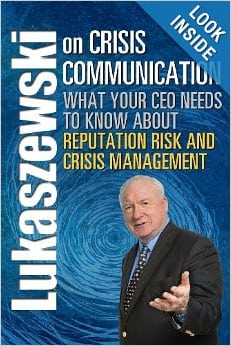Immediately following the tsunami that hit Japan in January of 2011, with more than 10,000 deaths and two nuclear plants disabled, Japanese authorities were initially reluctant to act for fear of damaging expensive nuclear equipment and possibly causing wider harm than what had already occurred. Yet this is how almost all corporate crisis responses begin.
Remember the BP oil spill of 2010? The stock market collapse? The credit card crunch? Enron? In practically every corporate and public disaster situation within recent memory, a certain pattern of leadership behavior has initially prevailed.
1. Denial: Denying that the situation is as serious as outside sources (and some inside sources), especially the news media, tend to declare, “Let’s not overreact.”
2. Resistance: Managers are fighting the cost of the crisis being assigned to their budgets, and worrying more about the condition of their equipment and assets than the damage being done and about victims being created through the crisis itself.
3. Bewilderment: The executives are huddling behind closed doors trying to figure out exactly what happened? Who is responsible? How can the blame be shifted away from the company? How can the company minimize what has been said about the situation itself and how can it maximize what has been said about the company’s prior good work?
4. Self-deception: Intentional minimizing, understating and withholding crucial information from the employees, the public and the victims, hoping that the situation can be remedied privately, easily and perhaps even heroically.
5. Self-talk: This usually takes the form of complaining about news media coverage, government interference, regulation and unknowledgeable or inexperienced oversight; and about people without credentials getting too much power and visibility.
6. Victim confusion/self-forgiveness: Talk revolves around how much the company itself is suffering, that despite its wonderful history of corporate social responsibility, it has now become a victim of overzealous politicians, activists, opportunistic reporters and unqualified people trying to extort compensation and distort reality.
7. Management by whining around: The stress, tension, constant mistakes and outside pressure is very wearing on executives in charge of responding. Unfortunately, in today’s nanosecond-deadline media environment, even a sincere expression of frustration and anguish can be misinterpreted.
THE BLUNT REALITY
This sequence of events or one closely resembling it is repeated in nearly every major and minor disaster and catastrophic situation. This is the pattern of management in crisis. The blunt reality is, however, that because all crises and their creation of victims happen so explosively and the resolution of these extraordinary problems and challenges can take place only incrementally, the odds of any crisis being handled promptly and appropriately are relatively small, especially as the complexity of the situation grows.
Those who manage crisis, those who communicate about crisis and those from management who will be paralyzed by crisis, need to understand three powerful realities:
• All crisis responses are mistake-prone: They are riddled with errors, and underestimate the intensity or seriousness of the situation. Lesson: It is always better to overstate the issues, understate the preparation and capacity and overreact from the very beginning.
• Crisis management always causes management to be in a crisis: These situations should be discussed far more openly, and far more quickly, probably as they are occurring. Shortcomings, what isn’t known, and what needs to be learned must be exposed, disclosed and discussed continuously.
Lesson: If the perpetrator fails to talk about the true situation, someone else almost certainly will. And those who talk will control the destiny of those who chose to remain silent.
• Heads often roll in crisis situations: Because those who lead, manage and talk are put under extraordinary strain and pressure by their own behavior, mistakes and attempts to minimize the situation. Lesson: Put someone in charge immediately who knows what to do. Give that person a checkbook and an army, and then get out of the way.
DON’T REPEAT THE PAST
In virtually every crisis situation, right along with the screaming headlines and the agitating journalists, far too many public relations practitioners are right in there criticizing, pandering and puffing. From a management perspective, these PR comments are simply uninformed staff level jibber-jabber which fail to address the critical operating issues and questions that crisis always creates. And they don’t help management get back on track faster.
For communicators, the most important lesson of all is to say things that matter, do things that matter and be prepared to give useful information and advice on the spot. The communicator should suggest operational actions that matter, and focus on helping management resolve its internal crises and anguish by recommending important, constructive next-step operating options. PRN
 (This is a book excerpt from “Lukaszewski on Crisis Communication: What Your CEO Needs to Know About Reputation Risk and Crisis Management,” Rothstein Associates, March 2013.)
(This is a book excerpt from “Lukaszewski on Crisis Communication: What Your CEO Needs to Know About Reputation Risk and Crisis Management,” Rothstein Associates, March 2013.)
CONTACT:
James Lukaszewski, [email protected].
This article appeared in the October 7 issue of PR News. Subscribe to PR News today to receive weekly comprehensive coverage of the most fundamental PR topics from visual storytelling to crisis management to media training.
